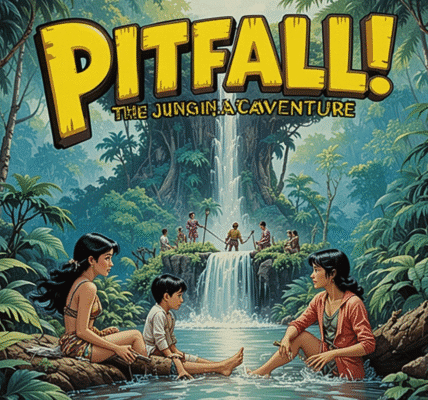Adventure (1979) for the Atari 2600: A Pioneering Quest in Pixels

In the autumn of 1979, Atari released a title that would quietly redefine what video games could be: Adventure for the Atari 2600. Far from the twitch‐based reflex challenges that dominated the fledgling console market, Adventure introduced the idea of exploration, object interaction, and narrative gaming—all in gloriously blocky graphics and a palette of just a few colors. Designed by Warren Robinett, Adventure remains one of the earliest and most influential action‐adventure games, planting seeds that would sprout into vast, richly woven digital worlds over the next four decades.
Conception and Development
Warren Robinett, who had already made a name for himself on the Atari 2600 with Slot Machine and Dragster, conceived Adventure as a way to push the hardware beyond simple scoring and fixed patterns. Inspired by text‐based computer adventures such as Colossal Cave Adventure (1976), Robinett wanted to bring a rudimentary sense of environment and discovery to a joystick‐controlled interface. Working at home on a borrowed Atari 2600 development kit, he spent months coding in assembly language, shuffling bytes to cram as much content as possible into the console’s meager 4 kilobytes of ROM and 128 bytes of RAM.
Despite its minimalist resources, Adventure features three distinct “castles” (rooms), a maze, roaming dragons, keys of different colors, and a valuable chalice to retrieve. Each item and obstacle had to be ingeniously encoded: walls are drawn as solid rectangles, creatures are simple squares, and every graphic is rendered with the same sweeping patience Robinett used to fit them into the tiny memory space. The ingenious use of “object registers” allowed for multiple moving elements onscreen, one of the Atari 2600’s greatest technical hurdles.
Gameplay Mechanics
At its core, Adventure places the player in control of a small square avatar, sometimes referred to today by fans as “the little square.” The overarching goal is elegantly simple: recover the golden chalice from the confines of the Black Castle and return it to the Gray Castle’s “castle keep.” To do this, players must navigate a connected network of screens, collecting color‐coded keys to open corresponding castle gates, avoiding or outsmarting three dragons (Magenta, Yorgle, and Rhindle), and solving the ever‐shifting maze that guards the Black Castle.
The controls are intuitive: use the joystick to move in four directions, push the single action button to pick up or drop an object, or to “throw” it—crucial when fending off dragons by tossing the magical bridge or blowing a key away to distract a beast. A roaming “bat” (a clever programming hack) scoops up and relocates either the player’s avatar or any item, sometimes stranding the player in a room with no exit or moving a needed key into the dragon’s lair. This unpredictability adds a thrilling, rogue‐like element of risk, forcing players to think ahead and improvise.
The First Easter Egg
Perhaps Adventure’s most famous legacy is the very first known Easter egg in a commercial video game. Atari’s company policy at the time forbade crediting programmers in game manuals, but Robinett quietly inserted a hidden room bearing the message “Created by Warren Robinett.” To access it, players had to find a pixel‐sized invisible dot tucked on one screen, pick it up (by positioning the square avatar over it and pressing the action button), then carry it to a wall and pass through. This secret tribute paved the way for countless developers to hide their own signatures inside games, forging a playful dialogue between creator and player that continues to this day.
Visuals and Sound
By modern standards, Adventure’s visuals are extremely primitive: large blocks of color on a solid black background, with each room rendered as a static frame. Yet within these constraints, Robinett managed to give each environment a distinct feel. The Gray Castle’s warm hues contrast sharply with the oppressive Black Castle, while the winding corridors of the maze loom ominously. The dragons’ simple square forms belied their threat: bump into one, and the chalice or a key might be lost forever. Sound design is minimal—just basic beeps and boops for movements, collisions, and item pickups—but these tones feel perfectly suited to the Atari’s limited audio hardware, reinforcing the game’s off‐kilter fantasy ambiance.
Reception and Impact
Upon release, Adventure was a sleeper hit. Players who expected the usual high‐score chase of Combat or the single‐screen action of Space Invaders found themselves embarking on a genuine quest. Word of mouth spread: gamers exchanged rumors of secret rooms, maps of the maze’s shifting layout, and tips for pacifying the dragons. While exact sales figures are murky, estimates place Adventure in the top tier of Atari 2600 sellers for the early 1980s. More importantly, it demonstrated the viability of longer‐form game design on home consoles, inspiring a generation of developers to think beyond arcades and reflex testing.
Legacy in Modern Gaming
In many ways, Adventure laid the groundwork for entire genres. Its concept of an overworld of interconnected rooms, collectible keys, and mobile inventory items can be seen echoed in games like The Legend of Zelda (1986) and onward through countless dungeon crawlers and open‐world titles. Even the very term “Easter egg” as applied to hidden content in software owes its origin to Adventure’s secret room. Modern indie titles frequently tout their “homage to Atari” aesthetics, and few pay tribute as directly as pixelated quests that recall the original’s spirit of exploration and surprise.
Ports, Remakes, and Homages
Over the years, Adventure has been ported and remade for various platforms. The Atari 8‐bit computers received a nearly identical version, and ports for modern systems have appeared within Atari Anthology collections on PlayStation, Xbox, and PC. Fan projects—often open‐source—have reimagined Adventure in high resolution, with enhanced soundtracks and expanded maps, yet the core loop remains unchanged: find the chalice, dodge the dragons, and maybe discover a hidden developer credit.
Why Adventure Endures
At its heart, Adventure thrives because it trusts players. It presents no tutorial pop‐ups or hand‐holding arrows; instead, it offers icons and context‐free mechanics for the player to puzzle out. Each play session feels intimate and personal: the slightest misstep can cost you hours of progress, while the triumphant moment of returning the chalice feels hard‐earned. This blend of minimalist design and emergent complexity still resonates in modern indie hits like Cave Story and Fez, proving that big ideas need not demand big budgets or lavish graphics.
Conclusion
Over forty years after its debut, Adventure remains a touchstone for game designers and players alike. Warren Robinett’s ingenuity in squeezing a multi‐room fantasy world into 4 KB of ROM stands as a testament to creativity under constraint. The joy of discovering hidden secrets, the thrill of outwitting pixelated dragons, and the pride of mastering an unmarked quest are experiences as fresh today as they were in 1979. In an era of ever‐more elaborate worlds, revisiting Adventure reminds us that at the core of gaming lies simple wonder—and the enduring magic of discovery.




